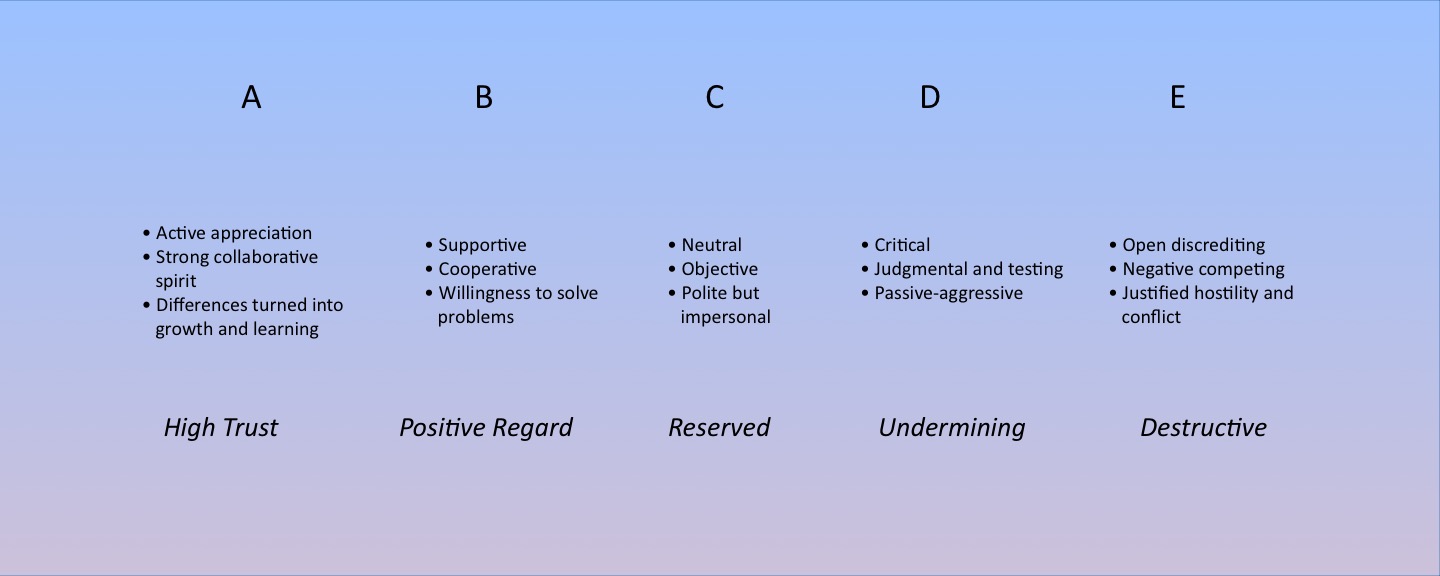Let’s say there is a scale of effective relating — it goes from high trust and collaboration at one pole to destructive hostility at the other. In between there are some intermediary points, so that we get something like the following. Please click on the graph to make it larger.
What the graph displays is an oversimplification, of course. There are many ways of relating, more nuanced, with more layers. The point is that in any given relationship there are always cues being picked up about the nature of the relationship two people have.
One way conflict in this relationship shows up is via what I believe I am expressing toward you vs. what I believe I am receiving from you.
For example, I might believe I am offering you support and cooperation (B), but I am receiving only judgment in return (D). The relationship then isn’t reciprocal. As a result, I may decide I want to build more trust with you and continue to operate as I do. This means I continue to make positive attempts and invitations to something better than what we currently have. In contrast, however, I may also decide, given your apparent behavior, that it is not worth it. In this case I may slide down the scale to meet you at judgment (D) in return. Or perhaps, I slide even further, given that you didn’t meet me at cooperation, dipping toward hostility and active discrediting (E).
As another, different kind of example, I may sense that you are offering an invitation to me to move toward a high trust style (A) but I also sense that I am more of a reserved, C kind of person, a little suspicious of such openness. I may feel drawn toward a risky leap out of my comfort zone — and will take my time about moving toward A, assuming you continue to treat me favorably.
The point is that what we want and what we receive from another may be very different and this creates all kinds of emotions. Consider, for instance, the vice-president who suddenly feels the CEO has a new favorite on the executive team. “It’s not that she’s no longer supportive of me,” the vice-president tells me, “but she doesn’t collaborate the way she used to, and sometimes she comes across in a rather cool, unforgiving way. Heck, we used to go out for drinks and talk for hours on end about how best to build the firm; now some days we just smile as we pass in the hall, hardly offering a greeting.”
This is a statement of conflict, loss, disappointment that comes with the demise of a particularly positive (A) reciprocity. I sense these things are more felt than thought out. The whole thing can be an almost unconscious process, a thing that happens to us in a relationship over which we imagine we have little say.
By the way, there’s nothing inherently bad about two people who say, “We’re at B (or C) and we don’t necessarily want to take it further.” That’s actually a statement of harmony around mutual expectations. For two people at D or E, however, reciprocity will feel quite different since their conflicts are most often highly dysfunctional. By comparison, differences at A have positive value and serve as a source of learning rather than mutual erosion.
This scale can be a useful tool when applied to conversations between people who work together. There are all kinds of implications and extensions that can be made. The conversation can begin with each person privately rating the relationship:
• Behavior I believe I am receiving from my partner.….….….…______(letter)
• Behavior I believe I am expressing toward my partner.….……______(letter)
The results are then shared between the partners. Facilitating the conversation aims to help each person see where they are and where they want to be by checking the reciprocity levels. The discussion can be quite enlightening (and sometimes painful) as feedback emerges: e.g., “You say you believe you are expressing B, but I don’t experience that — I’m getting C at best and D most of the time!”)
All of that is less important than the lesson, of course — which is that we all have choices to make around our relationships. I can choose to enter a more collaborative, high trust relationship with you, or choose to not go there with you; keep trying or give up. I can choose to explain why higher trust between us doesn’t work for me — or not. I can choose to ask you more effectively and directly for what I need, and I can choose to listen to your needs in return. It’s not about blaming one another for the relationship that is. It’s about being clear as to the choices we have already made and now intend to make to invite another person into or deter them from the relationship we both own. In my experience, people in conflict often find that they do want things to change and they are willing to make commitments about their own behavior to that end. The feedback that illuminates the discrepancies between what I think I am expressing versus what I actually leak into a relationship may very well be a surprising catalyst to deeper self-knowledge and change.
©2015 Daniel K. Oestreich (post and graphic). All rights reserved.
Singing Group — Afro-Latino Festival, Seattle
RSS and email subscription, occasional Unfolding Leadership newsletter, search and other functions may be found at the “Further Information” tab at the bottom of the front page.
Pinterest users, you can pin pictures from this weblog via this Board.


Dan,
I really like this model in how to think about relationships and what may be off balance. There seems like there is another category in between C and D. In this in-between category, there is friendliness along with a unwillingness to understand what a person really does and the corresponding results. Instead, the individual just assumes they know best or assume the worst.
This category is not quite D and it isn’t quite C. I realize there are gradients, and this may be one.
Thought-provoking and practical, as usual. Thank you!
Jon
Jon~
Like you, I love playing with these models! Of course, there are all kinds of additions and layers and missing pieces. I think you point out a valuable one.
I am also intrigued by overlays — when a person receives a double-message. The cues seem A, but also in some way feel C or D.
The point is that a model like this one is always deficient and that if two people are talking about the holes and “what’s wrong with this model,” that, too, can be a way to begin a conversation about what is true for them. If the model can stimulate that, no matter what literal categories it exhibits, then in my book it’s been a great success.
Thank you so much for stopping by, Jon. It’s always great to receive your insightful feedback!
Best
~Dan